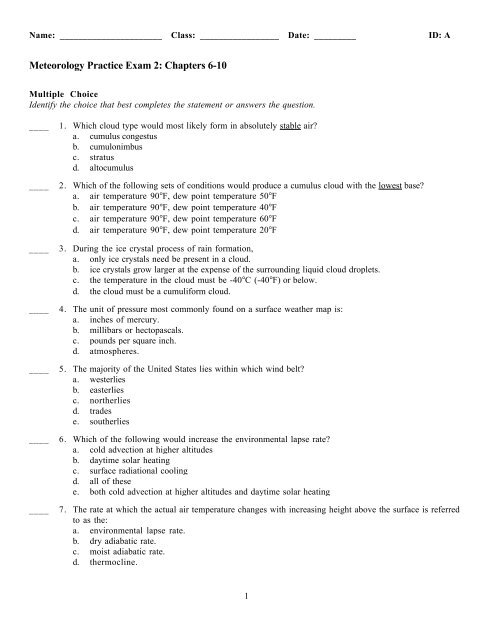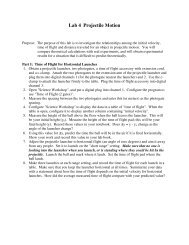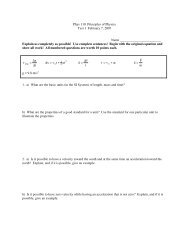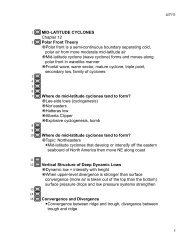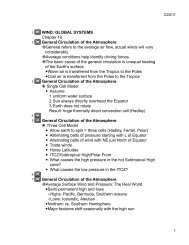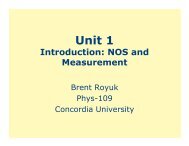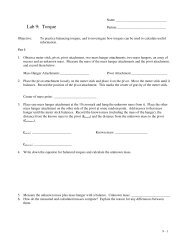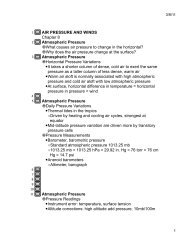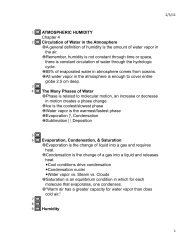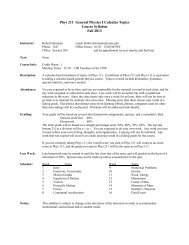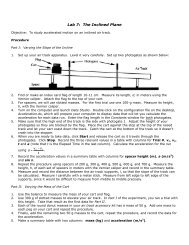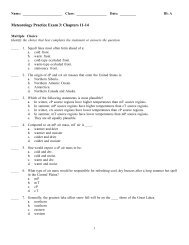Meteorology Practice Exam 2: Chapters 6-10
Meteorology Practice Exam 2: Chapters 6-10
Meteorology Practice Exam 2: Chapters 6-10
Create successful ePaper yourself
Turn your PDF publications into a flip-book with our unique Google optimized e-Paper software.
Name: ______________________ Class: _________________ Date: _________ ID: A<br />
<strong>Meteorology</strong> <strong>Practice</strong> <strong>Exam</strong> 2: <strong>Chapters</strong> 6-<strong>10</strong><br />
Multiple Choice<br />
Identify the choice that best completes the statement or answers the question.<br />
____ 1. Which cloud type would most likely form in absolutely stable air?<br />
a. cumulus congestus<br />
b. cumulonimbus<br />
c. stratus<br />
d. altocumulus<br />
____ 2. Which of the following sets of conditions would produce a cumulus cloud with the lowest base?<br />
a. air temperature 90°F, dew point temperature 50°F<br />
b. air temperature 90°F, dew point temperature 40°F<br />
c. air temperature 90°F, dew point temperature 60°F<br />
d. air temperature 90°F, dew point temperature 20°F<br />
____ 3. During the ice crystal process of rain formation,<br />
a. only ice crystals need be present in a cloud.<br />
b. ice crystals grow larger at the expense of the surrounding liquid cloud droplets.<br />
c. the temperature in the cloud must be -40°C (-40°F) or below.<br />
d. the cloud must be a cumuliform cloud.<br />
____ 4. The unit of pressure most commonly found on a surface weather map is:<br />
a. inches of mercury.<br />
b. millibars or hectopascals.<br />
c. pounds per square inch.<br />
d. atmospheres.<br />
____ 5. The majority of the United States lies within which wind belt?<br />
a. westerlies<br />
b. easterlies<br />
c. northerlies<br />
d. trades<br />
e. southerlies<br />
____ 6. Which of the following would increase the environmental lapse rate?<br />
a. cold advection at higher altitudes<br />
b. daytime solar heating<br />
c. surface radiational cooling<br />
d. all of these<br />
e. both cold advection at higher altitudes and daytime solar heating<br />
____ 7. The rate at which the actual air temperature changes with increasing height above the surface is referred<br />
to as the:<br />
a. environmental lapse rate.<br />
b. dry adiabatic rate.<br />
c. moist adiabatic rate.<br />
d. thermocline.<br />
1
Name: ______________________ ID: A<br />
____ 8. At the earth's surface, a rising saturated air parcel would cool most rapidly when its temperature is:<br />
a. <strong>10</strong>°F.<br />
b. 32°F.<br />
c. 50°F.<br />
d. 68°F.<br />
e. 80°F.<br />
____ 9. A completely dry air parcel which first rises and cools, and subsequently sinks and warms, is undergoing:<br />
a. an irreversible pseudoadiabatic process.<br />
b. a reversible adiabatic process.<br />
c. an irreversible adiabatic process.<br />
____ <strong>10</strong>. The dry adiabatic lapse rate is ____ greater than the moist adiabatic lapse rate.<br />
a. never<br />
b. sometimes<br />
c. always<br />
____ 11. The most latent heat would be released in a ____ parcel of ____ saturated air.<br />
a. rising; warm<br />
b. rising; cold<br />
c. sinking; warm<br />
d. sinking; cold<br />
____ 12. Which of the following conditions would be described as the most stable?<br />
a. Environmental lapse rate is 13°C per kilometer.<br />
b. Environmental lapse rate is 3°C per kilometer.<br />
c. isothermal conditions<br />
d. an inversion<br />
____ 13. Which of the following environmental lapse rates would represent the most unstable atmosphere in a<br />
layer of unsaturated air?<br />
a. 3°C per 1,000 m<br />
b. 6°C per 1,000 m<br />
c. 9°C per 1,000 m<br />
d. 11°C per 1,000 m<br />
____ 14. In a conditionally unstable atmosphere, the environmental lapse rate will be ____ than the moist<br />
adiabatic rate and ____ than the dry adiabatic rate.<br />
a. greater; less<br />
b. greater; greater<br />
c. less; greater<br />
d. less; less<br />
____ 15. If unsaturated stable air is lifted to a level where it becomes saturated and unstable, this type of instability<br />
is called:<br />
a. conditional instability.<br />
b. convective instability.<br />
c. baroclinic instability.<br />
d. forced instability.<br />
2
Name: ______________________ ID: A<br />
____ 16. Which cloud type below would most likely form in an unstable atmosphere?<br />
a. cumulonimbus<br />
b. stratus<br />
c. cirrostratus<br />
d. nimbostratus<br />
e. cumulus humilis<br />
____ 17. An example of orographic clouds would be:<br />
a. clouds forming over a warm ocean current.<br />
b. clouds forming on the windward slope of a mountain.<br />
c. clouds forming behind a jet airplane.<br />
d. clouds formed by surface heating.<br />
____ 18. An adiabatic chart is a useful tool for determining:<br />
a. a station model.<br />
b. isobars.<br />
c. the wind speed.<br />
d. the lifting condensation level.<br />
____ 19. Which condition below is necessary for a layer of altostratus clouds to change into altocumulus?<br />
a. The top part of the cloud deck cools while the bottom part warms.<br />
b. Temperature increases with increasing altitude in the layer.<br />
c. The cloud layer becomes more stable.<br />
d. All of these<br />
____ 20. Sinking air sometimes cools adiabatically.<br />
a. true<br />
b. false<br />
____ 21. The environmental lapse rate is almost always the same as the adiabatic lapse rate.<br />
a. true<br />
b. false<br />
____ 22. Conditional instability depends on the condition of:<br />
a. fog.<br />
b. low pressure.<br />
c. wind.<br />
d. saturation.<br />
____ 23. If you observe large raindrops hitting the ground, you could probably say that the cloud overhead was<br />
____ and had ____ updrafts.<br />
a. thick; weak<br />
b. thick; strong<br />
c. thin; weak<br />
d. thin; strong<br />
3
Name: ______________________ ID: A<br />
____ 24. If rain falls on one side of a street and not on the other side, the rain most likely fell from a:<br />
a. nimbostratus cloud.<br />
b. stratus cloud.<br />
c. cumulonimbus cloud.<br />
d. altostratus cloud.<br />
e. altocumulus cloud.<br />
____ 25. Which of the following statements is NOT correct?<br />
a. Generally, the smaller the pure water droplet, the lower the temperature at which it<br />
will freeze.<br />
b. Ice nuclei are more plentiful in the atmosphere than condensation nuclei.<br />
c. Much of the rain falling in middle northern latitudes begins as snow.<br />
d. Ice crystals may grow in a cold cloud even though supercooled droplets do not.<br />
____ 26. Supercooled cloud droplets are:<br />
a. ice crystals surrounded by air warmer than 0°C (32°F).<br />
b. liquid droplets that are cooler than the air around them.<br />
c. liquid droplets observed at temperatures below 0°C (32°F).<br />
d. water droplets that have had all their latent heat removed.<br />
____ 27. At the same sub-freezing temperature, the saturation vapor pressure just above a liquid water surface is<br />
____ the saturation vapor pressure above an ice surface.<br />
a. greater than<br />
b. the same as<br />
c. less than<br />
____ 28. Cloud seeding using silver iodide only works in:<br />
a. cold clouds composed entirely of ice crystals.<br />
b. warm clouds composed entirely of water droplets.<br />
c. cold clouds composed of ice crystals and supercooled droplets.<br />
d. cumuliform clouds.<br />
____ 29. The most common ice crystal shape:<br />
a. graupel.<br />
b. dendrite.<br />
c. rime.<br />
d. virga.<br />
____ 30. Fall streaks usually ____ before reaching the ground.<br />
a. evaporate<br />
b. condense<br />
c. sublimate<br />
d. deposit<br />
____ 31. Large, heavy snowflakes are associated with:<br />
a. dry air and temperatures well below freezing.<br />
b. moist air and temperatures well below freezing.<br />
c. dry air and temperatures near freezing.<br />
d. moist air and temperatures near freezing.<br />
4
Name: ______________________ ID: A<br />
____ 32. Fall streaks most often form with:<br />
a. nimbostratus clouds.<br />
b. cumulonimbus clouds.<br />
c. stratus clouds.<br />
d. altostratus clouds.<br />
e. cirrus clouds.<br />
____ 33. Which of the following might be mistaken for hail?<br />
a. virga<br />
b. graupel<br />
c. dendrite<br />
d. supercooled droplet<br />
____ 34. An amount of precipitation measured to be less than one hundredth of an inch (0.25 mm) is called:<br />
a. a trace.<br />
b. drizzle.<br />
c. light rain.<br />
d. mist.<br />
____ 35. If a city were to receive 1/2 inch of rain in the morning and then 5 inches of snow that afternoon, about<br />
how much precipitation would the weather service report for that day?<br />
a. 5 1/2 inches<br />
b. 1/2 inch<br />
c. 1 inch<br />
d. <strong>10</strong> inches<br />
____ 36. The water droplet and the ice crystal in the figure below have the same temperature. The saturation<br />
vapor pressure surrounding the water droplet will be ____ the saturation vapor pressure surrounding the<br />
ice crystal.<br />
a. lower than<br />
b. higher than<br />
c. the same as<br />
____ 37. Saturation vapor pressure ____ as temperature increases.<br />
a. increases<br />
b. decreases<br />
c. can't answer: it depends on whether the cloud has ice crystals or cloud droplets.<br />
____ 38. The surface pressures at the bases of warm and cold columns of air are equal. Air pressure in the warm<br />
column of air will ____ with increasing height ____ than in the cold column.<br />
a. decrease; more rapidly<br />
b. decrease; more slowly<br />
c. increase; more rapidly<br />
d. increase; more slowly<br />
5
Name: ______________________ ID: A<br />
____ 39. Suppose a parcel of air has a given temperature, pressure, and density. If the parcel's size remains the<br />
same while its temperature increases, then the air pressure inside the parcel will:<br />
a. decrease.<br />
b. decrease to but not lower than 1,000 mb.<br />
c. increase.<br />
d. remain constant.<br />
____ 40. If surface air pressure decreases, the height of the column in a mercury barometer would:<br />
a. remain constant.<br />
b. increase.<br />
c. decrease.<br />
d. change momentarily, but return to its earlier reading.<br />
____ 41. An aneroid barometer works on the principle that:<br />
a. mercury will rise and descend in a tube when the air pressure changes.<br />
b. the force of gravity decreases in strength with increasing altitude.<br />
c. a small closed cell with most of its air removed will expand and contract with changes<br />
in air pressure.<br />
d. a change in pressure causes a weak electrical signal in a ceramic detector.<br />
e. a change in air pressure causes a simultaneous change in air temperature that is<br />
detected with a sensitive thermometer.<br />
____ 42. The surface weather map is a sea level chart. Thus, a surface weather map is also called:<br />
a. a constant pressure chart.<br />
b. a constant height chart.<br />
c. an isobaric chart.<br />
d. a constant latitude chart.<br />
____ 43. On a weather map, ridges are:<br />
a. elongated low pressure areas.<br />
b. dying hurricanes.<br />
c. mountains that stall the movement of storms.<br />
d. elongated high pressure areas.<br />
e. tornadoes that touch the surface.<br />
____ 44. The contour lines drawn on a 500 mb chart are lines of constant:<br />
a. pressure.<br />
b. altitude.<br />
c. density.<br />
d. wind direction.<br />
____ 45. On an upper-level chart, normally we find warm air associated with ____ pressure, and cold air associated<br />
with ____ pressure.<br />
a. high; high<br />
b. high; low<br />
c. low; low<br />
d. low; high<br />
6
Name: ______________________ ID: A<br />
____ 46. Which of the following can influence wind direction?<br />
a. Coriolis force<br />
b. pressure gradient force<br />
c. centripetal force<br />
d. all of these<br />
____ 47. Which of the following forces CANNOT act to change the speed of the wind?<br />
a. pressure gradient force<br />
b. frictional force<br />
c. Coriolis force<br />
d. none of these<br />
____ 48. Which of the statements below is NOT correct concerning the pressure gradient force?<br />
a. The PGF points from high to low pressure in the Northern Hemisphere.<br />
b. It is non-existent at the equator.<br />
c. It can cause the wind to speed up or slow down.<br />
d. The PGF points from high to low pressure in the Southern Hemisphere.<br />
____ 49. The rate of the earth's rotation determines the strength of the:<br />
a. pressure gradient force.<br />
b. Coriolis force.<br />
c. frictional force.<br />
d. gravitational force.<br />
____ 50. Suppose that the winds aloft are geostrophic and blowing from the north. Low pressure is located to the:<br />
a. north.<br />
b. south.<br />
c. east.<br />
d. west.<br />
____ 51. If in the Northern Hemisphere the upper level winds above you are blowing from the south, then it is a<br />
good bet that a trough of low pressure is to the ____ of you.<br />
a. north<br />
b. south<br />
c. east<br />
d. west<br />
____ 52. The wind around a surface low pressure center in the Southern Hemisphere blows:<br />
a. counterclockwise and outward from the center.<br />
b. counterclockwise and inward toward the center.<br />
c. clockwise and outward from the center.<br />
d. clockwise and inward toward the center.<br />
____ 53. Cyclonic flow means ____ in either the Northern or Southern Hemisphere.<br />
a. clockwise wind flow<br />
b. counterclockwise flow<br />
c. circulation around a low pressure center<br />
d. circulation around a high pressure center<br />
7
Name: ______________________ ID: A<br />
Exhibit 8-4<br />
____ 54. Refer to Exhibit 8-4. Assuming that the figure above is in the northern hemisphere, the wind will end up<br />
blowing in a:<br />
a. clockwise direction.<br />
b. counterclockwise direction.<br />
Exhibit 8-5<br />
____ 55. Refer to Exhibit 8-5. The figure above depicts ____ winds.<br />
a. surface-level<br />
b. upper-air<br />
____ 56. The smallest scale of atmospheric motion is the:<br />
a. mesoscale.<br />
b. synoptic scale.<br />
c. microscale.<br />
d. macroscale.<br />
e. global scale.<br />
____ 57. Thermal turbulence above the surface is usually most severe:<br />
a. immediately after sunset.<br />
b. at the time of maximum surface heating.<br />
c. around midnight.<br />
d. just before sunrise.<br />
e. about midmorning, or soon after the minimum temperature is reached.<br />
8
Name: ______________________ ID: A<br />
____ 58. The top of the friction layer is usually found near what altitude?<br />
a. <strong>10</strong>0 m (330 ft)<br />
b. 500 m (1,640 ft)<br />
c. 1,000 m (3,300 ft)<br />
d. 5,000 m (16,400 ft)<br />
____ 59. Surface winds are generally strongest and most gusty:<br />
a. in the afternoon.<br />
b. in the early morning.<br />
c. around midnight.<br />
d. just after sunset.<br />
e. just before sunrise.<br />
____ 60. Clear air turbulence often occurs near a boundary of high wind shear.<br />
a. true<br />
b. false<br />
____ 61. The size and shape of a turbulent eddy depend on:<br />
a. the size of the obstacle.<br />
b. the shape of the obstacle.<br />
c. the speed of the wind.<br />
d. all of these<br />
e. only size and shape of the obstacle.<br />
____ 62. Suppose a west wind of 20 knots blows over a coastal region which is densely covered in shrubs. If this<br />
same wind moves out over the middle of a large calm lake, its speed and direction would probably be:<br />
a. greater than 20 knots and more northwesterly.<br />
b. less than 20 knots and more northwesterly.<br />
c. greater than 20 knots and more southwesterly.<br />
d. less than 20 knots and more southwesterly.<br />
e. less than 20 knots and westerly.<br />
____ 63. An instrument used to measure wind speed is called a(n):<br />
a. anemometer.<br />
b. ceilometer.<br />
c. psychrometer.<br />
d. tachometer.<br />
____ 64. A wind reported as 225° would be a wind blowing from the:<br />
a. NE.<br />
b. NW.<br />
c. SE.<br />
d. SW.<br />
____ 65. Which of the instruments below indicates both wind speed and wind direction?<br />
a. wind vane<br />
b. aerovane<br />
c. cup anemometer<br />
d. psychrometer<br />
e. theodolite<br />
9
Name: ______________________ ID: A<br />
____ 66. During the summer in humid climates, nighttime clouds tend to form over water during a:<br />
a. land breeze.<br />
b. chinook wind.<br />
c. sea breeze.<br />
d. Santa Ana wind.<br />
____ 67. A sea breeze circulation will reverse direction and become a land breeze:<br />
a. once every few days.<br />
b. at the beginning and the end of the summer.<br />
c. several times per day.<br />
d. once per day.<br />
____ 68. A cool, summertime wind that blows from sea to land is called a:<br />
a. Santa Ana wind.<br />
b. land breeze.<br />
c. valley breeze.<br />
d. sea breeze.<br />
____ 69. Clouds and precipitation are frequently found on the downwind side of a large lake. This would indicate<br />
that the air on the downwind side is:<br />
a. converging and rising.<br />
b. converging and sinking.<br />
c. diverging and sinking.<br />
d. diverging and rising.<br />
____ 70. Monsoon depressions are:<br />
a. huge drainage gullies that are produced during the heavy rains in the summer<br />
monsoon.<br />
b. upper-level jet streams.<br />
c. low pressure areas that enhance rainfall during the summer monsoon.<br />
d. large reservoirs used for irrigation that fill with water during the summer monsoon.<br />
e. a period of generally good weather with lower-than-average rainfall that may last for<br />
several days during the otherwise rainy summer monsoon.<br />
____ 71. A valley breeze would develop its maximum strength:<br />
a. at sunrise.<br />
b. in early afternoon.<br />
c. about an hour after sunset.<br />
d. about midnight.<br />
____ 72. The heat from a chinook wind is generated mainly by:<br />
a. compressional heating.<br />
b. sunlight.<br />
c. warm, ocean water.<br />
d. friction with the ground.<br />
e. forest fires.<br />
<strong>10</strong>
Name: ______________________ ID: A<br />
____ 73. The main reason Santa Ana winds are warm is because:<br />
a. latent heat is released in rising air.<br />
b. sinking air warms by compression.<br />
c. condensation occurs.<br />
d. solar heating warms the air.<br />
e. they are heated by forest fires in canyons.<br />
____ 74. Another name for a small, rotating whirlwind observed at the surface is:<br />
a. seiche.<br />
b. haboob.<br />
c. rotor.<br />
d. dust devil.<br />
e. foehn.<br />
____ 75. Strong winds blowing over a mountain may produce surface winds that blow in the opposite direction (see<br />
the diagram below).<br />
a. true.<br />
b. false.<br />
____ 76. The figure below shows a layer of relatively fast moving air overlying a layer of more slowly moving air.<br />
Where would you expect eddies and turbulent air motions to form?<br />
a. in the top layer<br />
b. in the bottom layer<br />
c. in the boundary between the two layers<br />
____ 77. The clouds shown in the figure below most likely form during the ____ when the land is ____ than the<br />
water.<br />
a. night; colder<br />
b. night; warmer<br />
c. day; colder<br />
d. day; warmer<br />
11
Name: ______________________ ID: A<br />
____ 78. Which of the following is a serious hazard to aircraft?<br />
a. molecular viscosity<br />
b. laminar flow<br />
c. clear-air turbulence<br />
d. longwaves in the westerlies<br />
e. none of these<br />
____ 79. Which below is NOT an assumption of the single-cell model of the general circulation of the<br />
atmosphere?<br />
a. The earth's surface is covered with water.<br />
b. The earth rotates once in 24 hours.<br />
c. The sun is always overhead at the equator.<br />
d. none of these<br />
____ 80. In terms of the three-cell model of the general circulation, areas of surface low pressure should be found<br />
at:<br />
a. the equator and the poles.<br />
b. the equator and 30° latitude.<br />
c. the equator and 60° latitude.<br />
d. 30° latitude and 60° latitude.<br />
e. 30° latitude and the poles.<br />
____ 81. At Barrow, Alaska (latitude 70°N), you would expect the prevailing wind to be:<br />
a. northerly.<br />
b. easterly.<br />
c. southerly.<br />
d. westerly.<br />
____ 82. According to the three-cell general circulation model, at the equator we would not expect to find:<br />
a. the ITCZ.<br />
b. a ridge of high pressure.<br />
c. cumuliform clouds.<br />
d. light winds.<br />
e. heavy showers.<br />
____ 83. On a weather map of the Northern Hemisphere, one would observe the westerlies:<br />
a. north of the subpolar lows.<br />
b. south of the tropical highs.<br />
c. between the doldrums and the horse latitudes.<br />
d. between the subpolar lows and the subtropical highs.<br />
____ 84. On a weather map of the Northern Hemisphere, the trade winds would be observed:<br />
a. north of the polar front.<br />
b. between the polar front and the subtropical highs.<br />
c. south of the subtropical highs.<br />
d. between the subpolar lows and the subtropical highs.<br />
12
Name: ______________________ ID: A<br />
____ 85. In the general circulation of the atmosphere, one would find the region called the doldrums:<br />
a. near 30° latitude.<br />
b. at the equator.<br />
c. at the poles.<br />
d. near 60° latitude.<br />
____ 86. Which of the following is not considered a semi-permanent high or low pressure area?<br />
a. Bermuda high<br />
b. Aleutian low<br />
c. Siberian high<br />
d. Pacific high<br />
e. Icelandic high<br />
____ 87. In the Northern Hemisphere, ocean currents in the Atlantic and the Pacific move in a generally circular<br />
pattern. The direction of this motion is ____ in the Atlantic and ____ in the Pacific.<br />
a. clockwise; counterclockwise<br />
b. counterclockwise; counterclockwise<br />
c. clockwise; clockwise<br />
d. counterclockwise; clockwise<br />
____ 88. The Ekman Spiral describes:<br />
a. the turning of water with depth.<br />
b. the air flow into a center of low pressure.<br />
c. the circulation of surface water around a gyre.<br />
d. the air flow out of a region of high pressure.<br />
e. the wind-flow pattern in a jet stream.<br />
____ 89. A condition where the central and eastern tropical Pacific Ocean turns cooler than normal is called:<br />
a. El Niño.<br />
b. La Niña.<br />
c. the Southern Oscillation.<br />
d. the Ekman Spiral.<br />
Essay<br />
90. Explain why it is much more difficult to measure snowfall amount than rainfall amount.<br />
91. Based on atmospheric stability considerations, do you think it would be best to burn agricultural debris in<br />
the early morning or the afternoon?<br />
92. What is the main difference between a raindrop and a cloud droplet?<br />
93. Suppose you stand outside and feel a fresh breeze blowing against your face. Could this be a geostrophic<br />
wind? Explain.<br />
94. You are hiking on a mountain trail at sunrise when you smell the smoke from cooking bacon. You can't<br />
see where the smoke is coming from. Would you expect the camp to be above you or below you on the<br />
mountain? Explain.<br />
13
Name: ______________________ ID: A<br />
95. On a large circle, show where the major pressure and wind belts would be found according to the 3-cell<br />
model of the earth's general circulation.<br />
14
<strong>Meteorology</strong> <strong>Practice</strong> <strong>Exam</strong> 2: <strong>Chapters</strong> 6-<strong>10</strong><br />
Answer Section<br />
MULTIPLE CHOICE<br />
1. ANS: C PTS: 1<br />
2. ANS: C PTS: 1<br />
3. ANS: B PTS: 1<br />
4. ANS: B PTS: 1<br />
5. ANS: A PTS: 1<br />
6. ANS: E PTS: 1<br />
7. ANS: A PTS: 1<br />
8. ANS: A PTS: 1<br />
9. ANS: B PTS: 1<br />
<strong>10</strong>. ANS: C PTS: 1<br />
11. ANS: A PTS: 1<br />
12. ANS: D PTS: 1<br />
13. ANS: D PTS: 1<br />
14. ANS: A PTS: 1<br />
15. ANS: A PTS: 1<br />
16. ANS: A PTS: 1<br />
17. ANS: B PTS: 1<br />
18. ANS: D PTS: 1<br />
19. ANS: A PTS: 1<br />
20. ANS: B PTS: 1<br />
21. ANS: B PTS: 1<br />
22. ANS: D PTS: 1<br />
23. ANS: B PTS: 1<br />
24. ANS: C PTS: 1<br />
25. ANS: B PTS: 1<br />
26. ANS: C PTS: 1<br />
27. ANS: A PTS: 1<br />
28. ANS: C PTS: 1<br />
29. ANS: B PTS: 1<br />
30. ANS: C PTS: 1<br />
31. ANS: D PTS: 1<br />
32. ANS: E PTS: 1<br />
33. ANS: B PTS: 1<br />
34. ANS: A PTS: 1<br />
35. ANS: C PTS: 1<br />
36. ANS: B PTS: 1<br />
37. ANS: A PTS: 1<br />
38. ANS: B PTS: 1<br />
39. ANS: C PTS: 1<br />
40. ANS: C PTS: 1<br />
1<br />
ID: A
41. ANS: C PTS: 1<br />
42. ANS: B PTS: 1<br />
43. ANS: D PTS: 1<br />
44. ANS: B PTS: 1<br />
45. ANS: B PTS: 1<br />
46. ANS: D PTS: 1<br />
47. ANS: C PTS: 1<br />
48. ANS: B PTS: 1<br />
49. ANS: B PTS: 1<br />
50. ANS: C PTS: 1<br />
51. ANS: D PTS: 1<br />
52. ANS: D PTS: 1<br />
53. ANS: C PTS: 1<br />
54. ANS: A PTS: 1<br />
55. ANS: A PTS: 1<br />
56. ANS: C PTS: 1<br />
57. ANS: B PTS: 1<br />
58. ANS: C PTS: 1<br />
59. ANS: A PTS: 1<br />
60. ANS: A PTS: 1<br />
61. ANS: D PTS: 1<br />
62. ANS: A PTS: 1<br />
63. ANS: A PTS: 1<br />
64. ANS: D PTS: 1<br />
65. ANS: B PTS: 1<br />
66. ANS: A PTS: 1<br />
67. ANS: D PTS: 1<br />
68. ANS: D PTS: 1<br />
69. ANS: A PTS: 1<br />
70. ANS: C PTS: 1<br />
71. ANS: B PTS: 1<br />
72. ANS: A PTS: 1<br />
73. ANS: B PTS: 1<br />
74. ANS: D PTS: 1<br />
75. ANS: A PTS: 1<br />
76. ANS: C PTS: 1<br />
77. ANS: D PTS: 1<br />
78. ANS: C PTS: 1<br />
79. ANS: B PTS: 1<br />
80. ANS: C PTS: 1<br />
81. ANS: B PTS: 1<br />
82. ANS: B PTS: 1<br />
83. ANS: D PTS: 1<br />
84. ANS: C PTS: 1<br />
85. ANS: B PTS: 1<br />
86. ANS: C PTS: 1<br />
2<br />
ID: A
ESSAY<br />
87. ANS: C PTS: 1<br />
88. ANS: A PTS: 1<br />
89. ANS: B PTS: 1<br />
90. ANS:<br />
Answer not provided.<br />
PTS: 1<br />
91. ANS:<br />
Answer not provided.<br />
PTS: 1<br />
92. ANS:<br />
Answer not provided.<br />
PTS: 1<br />
93. ANS:<br />
Answer not provided.<br />
PTS: 1<br />
94. ANS:<br />
Answer not provided.<br />
PTS: 1<br />
95. ANS:<br />
Answer not provided.<br />
PTS: 1<br />
3<br />
ID: A


